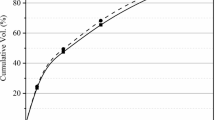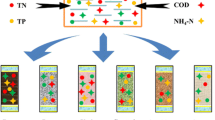Abstract
The bottom ash is increasingly used as a substitute aggregate material in road construction in China, and road salting is the major salt source in groundwater. Continuous rainfall releases soluble salts from the bottom ash subgrade into the surrounding soil and groundwater, resulting in potential hazards. Different methods were employed to simulate and collect runoff water during rainfall events, including batch leaching test, dynamic leaching test and constant head test, to assess environmental impact of bottom ash as road basement materials under continuous rainfall conditions. This study simulated the seepage of bottom ash backfill roads under different rainfall intensities, rainfall times, and rainfall pH values. A comprehensive sampling and laboratory testing program was undertaken to characterize the environmental impact of soluble salts from bottom ash. The obtained results reveal that the leaching concentrations of Cl− and SO42− exceed the limit specified in the class V standard of surface water, which are 2.06–2.17 times and 1.08–1.25 times, respectively. By examining the long-term environmental influence under the condition of continuous rainfall, the leaching of Cl− mainly occurs in the early leaching stage, and the maximum leaching concentration reaches 19,700 mg/L. The release concentration of Cl− begins to be lower than the class V standard of surface water when continuous rainfall approaches the total rainfall for 13 months. The cumulative release of Cl− in the bottom ash is 2.8–5.4 mg/g. Both rainfall intensity and rain pH affect the release of Cl−. The obtained results derived from the constant head tests indicate that stagnant water caused by rainfall deteriorates the release of soluble salt into the groundwater in only 1 day, especially at the early stage of 12 h. This work provides some basic information about how to minimize damage to the surrounding environment caused by the leaching of salt in bottom ash.










Similar content being viewed by others
Data availability
The authors confirm that the data supporting the findings of this study are available within the article.
References
Tang, Q., Zhang, Y., and Gao, Y.F. 2017. Use of cement-chelated, solidified, municipal solid waste incinerator (MSWI) fly ash for pavement material: Mechanical and environmental evaluations. Canadian Geotechnical Journal 54: 1553–1566. https://doi.org/10.1139/cgj-2017-0007.
Ministry of Environmental Protection of the People’s Republic of China. 2014. Standard for pollution control on the municipal solid waste incineration. GB 18485-2014.
Assi, A., Bilo, F., Zanoletti, A., et al. 2020. Zero-waste approach in municipal solid waste incineration: Reuse of bottom ash to stabilize fly ash. Journal of Cleaner Production 245: 118779. https://doi.org/10.1016/j.jclepro.2019.118779.
Joseph, A.M., Snellings, R., Nielsen, P., et al. 2020. Pre-treatment and utilisation of municipal solid waste incineration bottom ashes towards a circular economy. Construction and Building Materials 260: 120485. https://doi.org/10.1016/j.conbuildmat.2020.120485.
Clavier, K.A., Paris, J.M., Ferraro, C.C., et al. 2020. Opportunities and challenges associated with using municipal waste incineration ash as a raw ingredient in cement production—A review. Resources, Conservation and Recycling 160: 104888. https://doi.org/10.1016/j.resconrec.2020.104888.
Kalbe, U., and Simon, F.G. 2020. Potential use of incineration bottom ash in construction: Evaluation of the environmental impact. Waste and Biomass Valorization 11: 7055–7065. https://doi.org/10.1007/s12649-020-01086-2.
Vaitkus, A., Grazulyte, J., Sernas, O., et al. 2019. An algorithm for the use of MSWI bottom ash as a building material in road pavement structural layers. Construction and Building Materials 212: 456–466. https://doi.org/10.1016/j.conbuildmat.2019.04.014.
Sarmiento, L.M., Clavier, K.A., Paris, J.M., et al. 2019. Critical examination of recycled municipal solid waste incineration ash as a mineral source for portland cement manufacture—A case study. Resources, Conservation and Recycling 148: 1–10. https://doi.org/10.1016/j.resconrec.2019.05.002.
Alam, Q., Lazaro, A., Schollbach, K., et al. 2020. Chemical speciation, distribution and leaching behavior of chlorides from municipal solid waste incineration bottom ash. Chemosphere 241: 124985. https://doi.org/10.1016/j.chemosphere.2019.124985.
Guyonnet, D., Bodenan, F., Brons-Laot, G., et al. 2008. Multiple-scale dynamic leaching of a municipal solid waste incineration ash. Waste Management 28: 1963–1976. https://doi.org/10.1016/j.wasman.2007.07.007.
Wehrer, M., and Totsche, K.U. 2008. Effective rates of heavy metal release from alkaline wastes—Quantified by column outflow experiments and inverse simulations. Journal of Contaminant Hydrology 101: 53–66. https://doi.org/10.1016/j.jconhyd.2008.07.005.
Luo, H.W., Cheng, Y., He, D.Q., et al. 2019. Review of leaching behavior of municipal solid waste incineration (MSWI) ash. Science of the Total Environment 668: 90–103. https://doi.org/10.1016/j.scitotenv.2019.03.004.
Inkaew, K., Saffarzadeh, A., and Shimaoka, T. 2016. Modeling the formation of the quench product in municipal solid waste incineration (MSWI) bottom ash. Waste Management 52: 159–168. https://doi.org/10.1016/j.wasman.2016.03.019.
Yang, Z.Z., Tian, S.C., Liu, L.L., et al. 2018. Recycling ground MSWI bottom ash in cement composites: long-term environmental impacts. Waste Management 78: 841–848. https://doi.org/10.1016/j.wasman.2018.07.002.
Tasneem, K.M., Eun, J., and Nam, B. 2017. Leaching behaviour of municipal solid waste incineration bottom ash mixed with hot-mix asphalt and portland cement concrete used as road construction materials. Road Materials and Pavement Design 18: 687–712. https://doi.org/10.1080/14680629.2016.1186108.
Izquierdo, M., Querol, X., Josa, A., et al. 2008. Comparison between laboratory and field leachability of MSWI bottom ash as a road material. Science of the Total Environment 389: 10–19. https://doi.org/10.1016/j.scitotenv.2007.08.020.
Hyks, J., Astrup, T., and Christensen, T.H. 2009. Leaching from MSWI bottom ash: evaluation of non-equilibrium in column percolation experiments. Waste Management 29: 522–529. https://doi.org/10.1016/j.wasman.2008.06.011.
Drincic, A., Nikolic, I., Zuliani, T., et al. 2017. Long-term environmental impacts of building composites containing waste materials: Evaluation of the leaching protocols. Waste Management 59: 340–349. https://doi.org/10.1016/j.wasman.2016.11.003.
Alam, Q., Schollbach, K., van Hoek, C., et al. 2019. In-depth mineralogical quantification of MSWI bottom ash phases and their association with potentially toxic elements. Waste Management 87: 1–12. https://doi.org/10.1016/j.wasman.2019.01.031.
Ministry of Environmental Protection of the People’s Republic of China. 2007. Solid waste-Extraction procedure for leaching toxicity-Acetic acid buffer solution method. HJ/T 300-2007.
Ministry of Environmental Protection of the People’s Republic of China. 2010. Solid waste-Extraction procedure for leaching toxicity-Horizontal vibration method. HJ 557-2010.
Ministry of Environmental Protection of the People’s Republic of China. 2016. Water Quality-Determination of Inorganic Anions(F–, Cl–, NO2–, Br–, NO3–, PO43–, SO32–, SO42–)-Ion Chromatography. HJ 84-2016.
Ministry of Communications of the People’s Republic of China. 2019. Technical Specifications for Construction of Highway Subgrades. JTG 3610-2019.
Ministry of Environmental Protection of the People’s Republic of China. 2002. Environmental quality standards for surface water. GB 3838-2002.
Di Gianfilippo, M., Hyks, J., Verginelli, I., et al. 2018. Leaching behaviour of incineration bottom ash in a reuse scenario: 12 years-field data vs. Lab test results. Waste Management 73: 367–380. https://doi.org/10.1016/j.wasman.2017.08.013.
Chen, C.H., and Chiou, I.J. 2007. Distribution of chloride ion in MSWI bottom ash and de-chlorination performance. Journal of Hazardous Materials 148: 346–352. https://doi.org/10.1016/j.jhazmat.2007.02.046.
Silva, R.V., de Brito, J., Lynn, C.J., et al. 2019. Environmental impacts of the use of bottom ashes from municipal solid waste incineration: A review. Resources, Conservation and Recycling 140: 23–35. https://doi.org/10.1016/j.resconrec.2018.09.011.
Gunasekara, C., Law, D.W., Setunge, S., et al. 2015. Zeta potential, gel formation and compressive strength of low calcium fly ash geopolymers. Construction and Building Materials 95: 592–599. https://doi.org/10.1016/j.conbuildmat.2015.07.175.
Balakin, B.V., Shamsutdinova, G., and Kosinski, P. 2015. Agglomeration of solid particles by liquid bridge flocculants: Pragmatic modelling. Chemical Engineering Science 122: 173–181. https://doi.org/10.1016/j.ces.2014.09.003.
Knox, R.G., Longo, M., Swann, A.L.S., et al. 2015. Hydrometeorological effects of historical land-conversion in an ecosystem-atmosphere model of northern South America. Hydrology and Earth System Sciences 19: 241–273. https://doi.org/10.5194/hess-19-241-2015.
Linh, H.N., Tamura, H., Komiya, T., et al. 2020. Simulating the impact of heavy rain on leaching behavior of municipal solid waste incineration bottom ash (MSWI BA) in semi-aerobic landfill. Waste Management 113: 280–293. https://doi.org/10.1016/j.wasman.2020.06.008.
Purandara, B.K., Varadarajan, N., and Venkatesh, B. 2008. Simultaneous transport of water and solutes under transient unsaturated flow conditions—A case study. Journal of Earth System Science 117: 477–487. https://doi.org/10.1007/s12040-008-0047-5.
Acknowledgements
The authors want to acknowledge the projects of the National Natural Science Foundation (No. 52170141, No. 52236008), the Key Research and Development Program of Zhejiang Province (No. 2022C03092) and Natural Science Foundation of Zhejiang Province (No. LZ23E060004), which provided financial support for this work.
Author information
Authors and Affiliations
Corresponding author
Ethics declarations
Conflict of interest
The authors of this manuscript have no conflicts of interest related to the content of the study. Yanjun Hu is the Editorial Board member of Waste Disposal & Sustainable Energy.
Additional information
Publisher's Note
Springer Nature remains neutral with regard to jurisdictional claims in published maps and institutional affiliations.
Rights and permissions
Springer Nature or its licensor (e.g. a society or other partner) holds exclusive rights to this article under a publishing agreement with the author(s) or other rightsholder(s); author self-archiving of the accepted manuscript version of this article is solely governed by the terms of such publishing agreement and applicable law.
About this article
Cite this article
Zhao, L., Zhang, D., Hu, Y. et al. Release behavior of soluble salts in MSWI bottom ash used as road basement materials under continuous rainfall conditions. Waste Dispos. Sustain. Energy 5, 525–534 (2023). https://doi.org/10.1007/s42768-023-00161-3
Received:
Revised:
Accepted:
Published:
Issue Date:
DOI: https://doi.org/10.1007/s42768-023-00161-3




